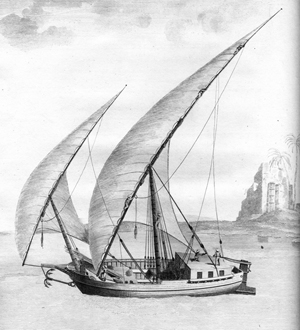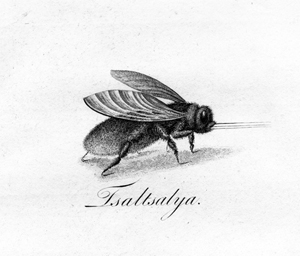
“Canja Under Sail”
Having now provided every thing necessary, and taken a rather melancholy leave of our very indulgent friends, who had great apprehension that we should never return; and fearing that our stay till the very excessive heats were past, might involve us in another difficulty, that of missing the Etresian winds, we secured a boat to carry us to Furshout, the residence of Hammam, the Shekh of Upper Egypt. This sort of vessel is called a Canja, and is one of the most commodius used on any river, being safe, and expeditious at the same time, though at first sight it has a strong appearance of danger. That on which we embarked was about 100 feet from stern to stem, with two masts, main and foremast, and two monstrous Latine sails; the main-sail yard being about 200 feet in length. . . . The keel is not straight, but a portion of a parabola whose curve is almost insensible to the eye. But it has this good effect in sailing, that whereas the bed of the Nile, when the water grows low, is full of sand banks under the water, the keel under the stem, where the curve is the greatest, first strikes up on these banks, and is fast, but the rest of the ship is afloat; so that by the help of oars, and assistance of the stream, furling the sails, you easily get off; whereas, was the keel straight, and the vessel going with the pressure of that immense main-sail, you would be so fast upon the bank as to lie there like a wreck for ever. [Vol. 1, pp. 43-44]

"Arab Shekh / Tribe Beni Koreish"
The three officers were genteel young men, of a sickly appearance, dressed in the fashion of the country, in long burnooses loosely hanging about them, striped with red and white; they wore a turban of red, green, and white, with ten thousand tassels and fringes hanging down to the small of their backs. They had in their hand, each, a short javelin, the shaft not above four feet and a half long, with an iron head about nine inches, and two or three iron hooks below the shaft, which was bound round with brass-wire, in several places, and shod with iron at the farther end. [Vol. I, p. 250]

“Arab of Loheia / Tribe Beni Koreish”
The women of Loheia are as solicitous to please as those of the most polished nations in Europe; and, though very retired, whether married or unmarried, they are not less careful of their dress and persons. At home they wear nothing but a long shift of fine cotton-cloth, suitable to their quality. They dye their feet and hands with henna, not only for ornament, but as an astringent, to keep them dry from sweat: they wear their own hair, which is plaited, and falls in long tails behind. The Arabians consider long and straight hair as beautiful. The Abyssinians prefer the short and curled. The Arabians perfume themselves and their shifts with a composition of musk, ambergrease, incense, and benjoin, which they mix. . . . They put all these ingredients into a kind of censer on charcoal, and stand over the smoke of it. The smell is very agreeable. . . . The Arab women are not black, there are even some exceedingly fair. They are more corpulent than the men. . . . [F]ew Arabian women have children after the age of twenty. [Vol. 3, pp. 307-8]

“One Sheet of Ethiopic Language”
The reader will understand, that, speaking of the Ethiopic at present, I mean only the Geez language, the language of the Shepherds, and of the books. None of the other many languages spoken in Abyssinia have characters for writing. . . . [T]here is an old law in this country, handed down by tradition only, that whoever should attempt to translate the holy scripture into Amharic, or any other language, his throat should be cut after the manner in which they kill sheep, his family sold to slavery, and his home razed to the ground. . . . The Geez is exceedingly harsh and unharmonious. It is full of these two letters, D and T, on which an accent is put that nearly resembles stammering. Considering the small extent of sea that divides this country from Arabia, we are not to wonder that it has great affinity to the Arabic. [Vol. 4, pp. 424-25]

“Papyrus”
The papyrus seems to me to have early come down from Ethiopia, and to have been used in Upper Egypt immediately after the disuse of hieroglyphics, and the first paper made from this plant was in Seide. By Seide was anciently meant Upper Egypt, and it is so called to this day. . . . The ancients divided this plant into three parts, the head and the small part of the stalk were cut off, then the woody part, or bottom, and the root connected with it, and there remained the middle. All these had separate uses. Pliny says the upper part, which supported the large top itself, with the flowers upon it, was of no sort of use but to adorn the temples, and crown the statues of the gods; but it would seem that it was in use likewise for crowning men of merit. . . . The top of the papyrus was likewise used for sewing and caulking the vessels. . . . The bottom, root, or woody part of this plant, was likewise of several uses before it turned absolutely hard; it was chewed in the manner of liquorice, having a considerable quantity of sweet juice in it. . . . This lower part was likewise used in making cups, moulds, and other necessary utensils. . . . [P]aper was made [using the middle part]. . . . The thick part of the stalk being cut in half, the pellicle between the pith and the bark, or perhaps the two pellicles, were stript off, and divided by an iron instrument, which probably was sharp-pointed, but did not cut at the edges. This was squared at the sides so as to be like a ribband, then laid upon a smooth table or dresser, after being cut into the length that it was required the leaf should be. These stripes, or ribbands of papyrus, were lapped over each other by a very thin border, and then pieces of the same kind were laid transversely, the length of these answering to the breadth of the first. . . . [T]he sugar or sweetness with which the whole juice of this plant is impregnated, is the manner that causes the adhesion of these stripes together. . . . The drawing represents the papyrus as growing. [Vol. 5, pp. 1-2, 5-10, 15]

“Tsaltsalya, or Fly” [Also known as the Zimb, it is related to the Tsetse fly. Here Bruce gives the first description of it in Western literature.]
This insect is called the Zimb; it has not been described by any naturalist. It is in size very little larger than a bee, of a thicker proportion, and his wings, which are broader than those of a bee, placed separate like those of a fly; they are of pure gauze, without colour or spot upon them; the head is large, the upper jaw or lip is sharp, and has at the end of it a strong-pointed hair of about a quarter of an inch long; the lower jaw has two of these pointed hairs, and this pencil of hairs, when joined together, makes a resistance to the finger nearly equal to that of a strong hog’s bristle. Its legs are serrated in the inside, and the whole covered with brown hair or down. As soon as this plague appears, and their buzzing is heard, all the cattle forsake their food, and run wildly about the plain, till they die, worn out with fatigue, fright, and hunger. No remedy remains, but to leave the black earth, and hasten down to the sands of Atbara, and there they remain while the rains last, this cruel enemy never daring to pursue them farther. [Vol 1, p. 388]
This insect which we have here before us is a proof how fallacious it is to judge by appearances. If we consider its small size, its weakness, want of variety or beauty, nothing in creation is more contemptible and insignificant. Yet passing from these to his history, and to the account of his powers, we must confess the very great injustice we do him from want of consideration. We are obliged, with the greatest surprise, to acknowledge, that those huge animals, the elephant, the rhinoceros, the lion and the tiger, inhabiting the same woods, are still vastly his inferiors, and that the appearance of this small insect, nay, his very sound, though he is not seen, occasions more trepidation, movement, and disorder, both in the human and brute creation, than would whole herds of these monstrous animals collected together . . . His operations are too materially interwoven with the history of this country to be left apart as an episode. [Vol. 5, pp. 188-89]